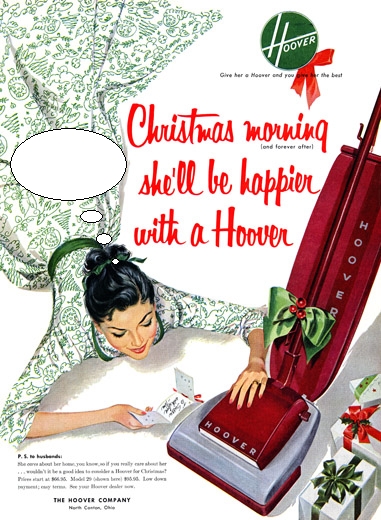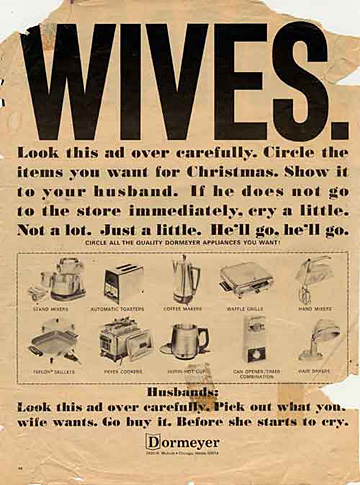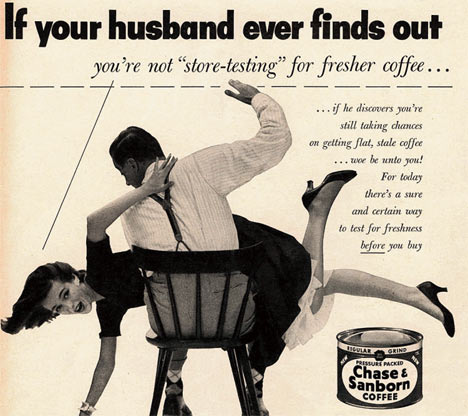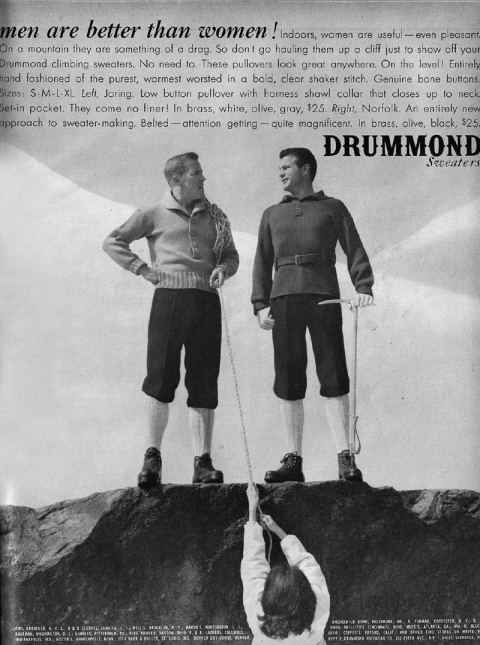-
Recent Posts
Recent Comments
- y8 happy wheels on 1950s Ads/commercials aimed at Women
- gorzow nieruchomosci on 19th century Household Technology
- When it comes to personal loans USA | 7N4ctwqy on Pros vs Cons of Gay Marriage
- idaho virtual office on Experience of Surrogacy
- Gansu, said construction lax control caused the day of a highspeed 31 kilo | www.louboutinpascher1221magasin.frkalF on Surrogacy in India
Frequent Topics
- 20th century
- 1950s
- Adolescents
- american dream
- anonymous
- birth
- census 2011
- childhood obesity
- children
- children under 2
- chores
- Christian fundamentalist
- commercial
- consumerism
- eugenics
- Family
- female targets
- Foucault
- gay
- Gay Marriage
- guest workers
- home economics
- homosexuality
- Homosexual Warning
- household roles
- Immigrants Hope Their 'American Dream' Isn't Fading
- kitchen
- majority not white
- marketing
- Media & Advertising
- minorities
- motherhood
- New York Times
- privacy
- Pros vs Cons of Gay Marriage
- school
- segmented marketing
- Slavery
- Social Media
- social network
- surrogacy
- television
- us population
- women
Archives
Categories
Meta
Tag Archives: consumerism
1 baby – 8 Mothers
I came upon an article of January of this year. Since we discussed home economics in class, I thought this might apply. Unlike the Amy Sue Bix article, whose focus was on the equipment program under home economics, this relates more to the branch of child development. This article came from ABC news and it is called “Practice Babies’: 1 Orphan Raised by 8 Mothers”. In the time when home economics was becoming quite popular and many women were attending colleges who offered degrees in this field, Cornell University was one of them. Surprisingly enough Ivy League Cornell offered the Home Economics degree, tuition free for these women. In 1919 as the final project for graduation for these women they initiated a program called the “practice baby program”. This required 8 women, up to 12, to care for a baby in an apartment. Then after 6 weeks the baby would be passed on two another set of women for up to 2 years, when finally they would be adopted. For those 6 weeks they care for the child 24 hours a day/ 7 days a week, along with other household chores part of their curriculum. They mention that one of these women might put the baby down for a nap to be later picked up by another woman. These babies were offered by the welfare program (loaned by orphanages) for the benefit of “science”.
 The babies were anonymous since they were infants, but they were all branded with the name Denny Domecon (surname: domestic economy). After leaving the child would have no contact with the multiple caregivers or vice versa. According to Keating, an archivist at Cornell:
The babies were anonymous since they were infants, but they were all branded with the name Denny Domecon (surname: domestic economy). After leaving the child would have no contact with the multiple caregivers or vice versa. According to Keating, an archivist at Cornell:
“The program was an early testing-ground for consumer research, a “gateway for early education for a different group of women who were so well educated”
The program was later dropped in 1969 when new research pushed society into the benefits of having a primary caregiver. But that wasn’t before Life magazine ran an article in 1952 glorifying the program. The apartments were later used as day care center. I’ve included a video of one of these women caregivers who got their degree in Home Economics from Cornell in 1925. Also a picture of the article from Life (“The Making of a Home: Cornell Girls Study for Their Big Job.”) Both of these women are the same person.
Posted in Assignment 4
Tagged 1950s, 20th century, children, consumerism, home economics, household roles, motherhood, women
3 Comments
children and consumption
From the beginning of the 1900’s marketers realized the potential to sell their products and services to children. The Children’s market became a very lucrative market for corporations in a very short period of time. The effect of this phenomenon is enormous. It has affected not only the children but changed society and with it changed the way family functions within.
From the moment the child is born, it is bombarded with commercials on a daily basis. Therefore, the child grows up consumed by it. As it is stated in the YouTube video, “we are creating super consumers”. Children grow up being consumed by brands and products that are reaching them anywhere and possible at any point of the day using multiple different channels. Big corporations spend a lot of time and resources in order to research and analyze children’s psychology. For example, children’s behavior that interactions with others, what they like to eat or what they want to wear and etc. This research helps them to target children and influence their consumption habits more precisely. Marketers that reach children from the infancy stage are trying to create brand loyalty for life and attach children emotionally to their brands.
In my opinion, this phenomenon is problematic for the children as well as society as a whole. US has no regulations for children’s commercials, therefore companies take advantage of the deregulation to their fullest extent. I believe parents should be involved in creating values and ideologies in their children’s lives and not corporations, by constantly pushing their brands on children. From my personal observations, the lack of time spent with the children and the guilt parents have due to time scarcity, influences the constants consumption of products and services that children demand from the parents. I believe by doing so and allowing children to have everything that they ask for, parents feel less guilty for not spending enough time with their children; therefore parents are as accountable as marketers in children’s consumerism. I believe, buying products and services doesn’t replace the lost time with the parents and children grow up feeling empty and lonely and the only way they know how to deal with it is, to consume more material things.
Consuming Kids
I found a documentary called Consuming Kids : The Commercialisation of Children. For sake of brevity I only watched and posted the first part (of seven). This documentary is directly related to the past few articles we have read in class. It includes a brief history of marketing and how kids are marketed too. It is not shocking at all to see that Ronald Reagan and the courts gave power to businesses and marketers rather than the FTC which represents the “people”. This has remained a common trend in politics and issues until this day. The money and influence of individuals is miniscule compared to the lobbying and funds distributed through large corporations. On the same token, parents and families should not be looking to the government for guidance in the media influencing their children. It is not pick and chose for every aspect the government should or should not regulate. If the people want America to be the consumer/capitalistic state that it is, we can not go crying to the government when it has unintended effects.
The amount of money that is pumped into the economy under the influence from children was truly amazing. Informative documentaries such as this one, should serve as a wake up call to parents and families to power they give to their kids and the amount and type of information they are exposed to. Although parents certainly cannot control everything their child sees and hears, they can help educate and influence the way their kids process information. Technology in the form of TV’s, the internet, and phones have had a profound influence on society today, but how the information they convey is interpreted and distributed is up to each person to decide.
Kitchens of the Future
I found on YouTube a 1956 GM promotional film “Design for dreaming” aimed for the upper-middle class as well as upper class. This film shows us how manufacturers were targeting and selling to only that specific target market. This promotional film is amazing, almost futuristic with specific goal to sell “dream life” to females that can afford it. I was surprised how technologically advanced the “dream kitchen” was in the film. The movie starts with a white female all dolled up singing around about how she wants to get a break like all men do as she enters this “dream kitchen” and she is about to bake cake. She begins to sing about how she has never seen a kitchen like this one and gets into the details by showing how easy is to press different buttons and everything gets done for you. After she finished putting ingredients in the different futuristic appliances she leaves the kitchen and sings “Tic Tock Tic Tock, free to have fun around the clock”. This shows us how manufacturers were focused onto not only selling appliances but the benefits that came with this kitchen such as: free time for leisure activities.
The lady leaves the kitchen and changes her clothes a few times in outfits for tennis, golf and swimming. The point is to show that, while her cake is baking she has time to do all these activities, after she comes back home her cake is magically ready. I found this film unrealistic even for our times, although maybe it is real in upper classes but I doubt that. In conclusion, this film proves that in 1950’s manufacturers were mainly concerned with female consumers that had enough disposable income, specifically white upper-middle class. I believe, this film is a perfect example of everything we have read in the class about the consumers of the postwar era and the target market before the influence of newly emerged “middle-class” that changed the way manufacturers segmented target audience.
Posted in Assignment 2
Tagged 1950s, consumerism, promotional film, television, upper-middle class, women
4 Comments
1950s Ads/commercials aimed at Women
In the 1950s women were the primary consumers; the ones who made decisions on what was needed at home. Therefore I was curious on how did the market researchers of the 1950s and 1960s market products to women. The first one is a commercial for a refrigerator from the 1950s made by the company Kelvinator Refrigerator. It reminded me of the “more is better” state of mind during this period. For everyone who sees it, please note the amount of food in that refrigerator (LOL). It made me wonder how many people lived in this home during this time.
Apart from finding the conventional cheerful ads from these times, I did encounter some that were not so jolly but quite sexist. Coming from a post-feminist perspective I thought they were quite hilarious. But I think it is interesting that albeit the sexist remarks projected by the ads, these women still bought the products marketed to them. Even if it continued to reaffirm the stereotypes of women during these decades. Most of the advertisement I came by during this period were either made for white women/wives/mothers and white families. But looking ahead in the late 1960s, I did see the transition into market segmentation. More ads were aimed at African Americans than before. What follows were ads marketing to women in the 1950s:






I particularly enjoy the last one because during these time researchers were also understanding that women were not the only ones they should market to; but men also.
Consumerism and Pop Culture
Pop culture is a very dynamic entity, it decides what’s cool, what’s lame and has the ability to tell people what to buy therefore can be the deciding factor in the financial decisions multi billionaires make. It’s also something that will inevitably change over and over again throughout time. I always wonder who is it really that controls pop culture, because it isn’t something tangible, we can’t hold it in our hands or ask it what the next cool thing is going to be. Pop culture is simply formed of ideas that are shared and filtered through word of mouth and whatever means of communication exist in that period of time whether it be the telephone, written mail, magazines, newspapers, e-mails, etc. Then those ideas get filtered again and picked up by the consumers, whichever idea becomes the most popular will have the most invested, time, interest, and money therefore becoming “cool.”
What was cool in the 50’s and 60’s may not be cool these days, marketing strategies were different, morals were different, ideals were different, and the climate of pop culture was different. It’s amazing to see that there were such blatantly bias/racist advertisements in the past decades of the United States until someone presented the idea that let’s get the most money out of EVERYONE possible no matter what race, or social class, let’s just make some money. I don’t mean to sound like an old man after all I’m only in my early 20’s but back when I was a kid the main consumer demographic was at the age of 18-30 years old. Nowadays it seems like with this new tween wave of consumerism the main demographic is ages 9-12, which is considerably smaller and since when did children have such influence over the financial industry anyway because let’s face it, what’s “cool” is what is going to be making money anyway. I don’t know where this came from and I’m not a big fan of it, but I don’t wish it gone from existence I just would like a reason to all this successful tween consumerism being thrown in my face every time I turn on the television. Again I’ll just chalk it up to the ever changing entity of pop culture and what was cool and okay to do back then is different now. I posted a YouTube video of an old Jell-O commercial that seems questionable if it were on the air today but again this is pop culture in the 1960’s for you guys. It can be considered a stereotypical and offensive commercial to people so I’m just putting that out there for anyone who clicks the YouTube video.
Take Care,
Ryhan Ahmad
Posted in Assignment 2
Tagged commercial, consumerism, cool, financial, pop culture, television, tween
3 Comments


